
by Amelie Meyer and Alexey Pavlov Friday, October 12, 2018
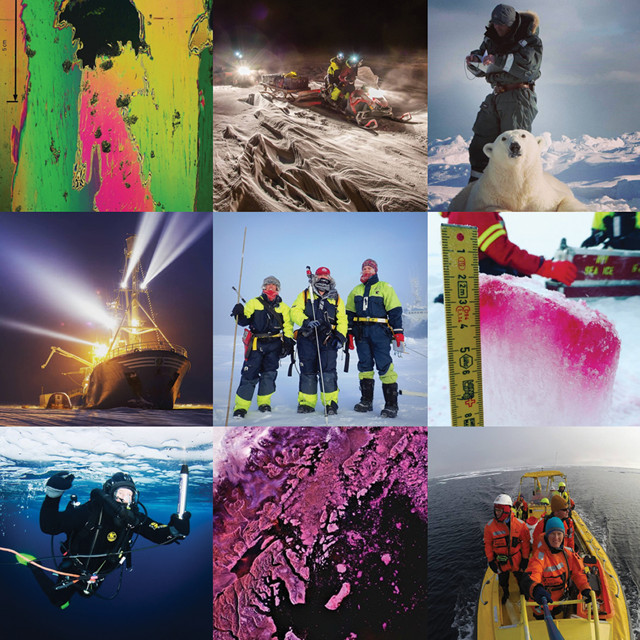
Scientists at the Norwegian Polar Institute (NPI) in Norway run a science outreach initiative using the handle @oceanseaicenpi. These photos were used in posts from their Instagram (www.instagram.com/oceanseaicenpi), Twitter (twitter.com/oceanseaicenpi) and Facebook (www.facebook.com/oceanseaicenpi) platforms. Credit: clockwise from top left: Elina Nystedt (NPI), Paul A. Dodd (NPI), Jon Aars (NPI), Sebastian Gerland (NPI), Anja Rösel (NPI), CopernicusEU/Mikhail Itkin (NPI), Peter Leopold (NPI), Nick Cobbing (National Geographic), Amelie Meyer (NPI).
Whether true or not, scientists are famous for not being great public communicators, yet communication is a key aspect of our work. Traditional science communication involves sharing findings with colleagues through published articles in peer-reviewed journals and presenting work at conferences. Scientists are encouraged to communicate using this well-defined framework and are rewarded for doing so; in fact, our career progress is often assessed using such publication records. Meanwhile, communication with wider audiences might entail visits with schoolchildren or perhaps talking to journalists for stories in a magazine like this one. But sharing findings with and promoting science to the public is a less-defined task, and often one with few incentives and little support. That communicating with wider audiences isn’t encouraged is unfortunate considering many of us are funded by the public to research and answer questions relevant to society. We should clearly communicate our findings to the public, especially regarding complex topics such as climate change.
But we can take matters into our own hands: The internet, and social media platforms in particular, have opened simple and inexpensive avenues to communicate with the public. Science communication using social media not only has the potential to reach the public, but it also benefits scientists in many ways.
In early 2014, our team, the Oceans and Sea Ice research group at the Norwegian Polar Institute in Tromsø, Norway, created the @oceanseaicenpi handle on Instagram (www.instagram.com/oceanseaicenpi), Twitter (twitter.com/oceanseaicenpi) and Facebook (www.facebook.com/oceanseaicenpi) to communicate our science to the public and develop networks within the professional polar science community.
So far, our combined audience across these three platforms has grown to more than 7,000 followers in more than 100 countries. With each post, we reach many more people across a much broader area than we would by more conventional means. Our experience has been very positive: Using social media has increased our connection to the public, helped us become better communicators, grown our networks, and significantly increased the visibility of our research. Additionally, highlighting our peer-reviewed science papers through the @oceanseaicenpi channels has increased alternative metrics (altmetrics) scores that reflect the online impact of these papers, often beyond the scientific community. Highlighted papers also get more reads and more citations.
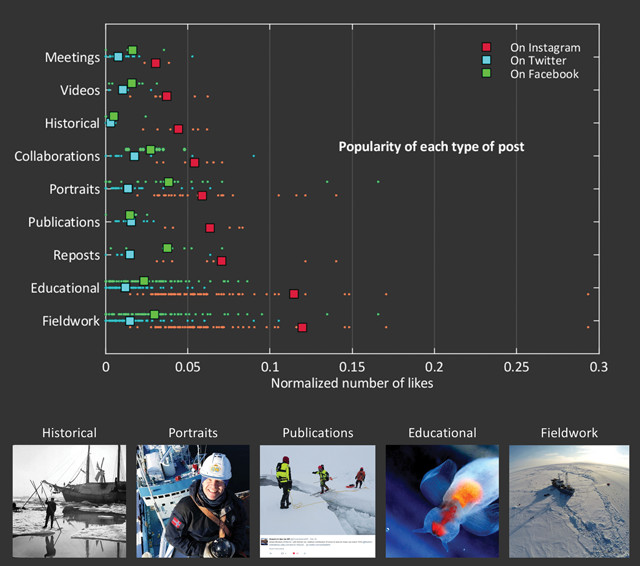
Popularity of each type of post based on likes on Instagram (red), retweets on Twitter (blue), and likes on Facebook (green), where the number of likes or retweets has been normalized by the number of followers at the time of the post. Small dots represent individual posts, while large squares are the mean for each type of post. Note that the x-axis has been truncated for clarity and that some posts reached values close to 1. Credit: from left to right: Henrik Blessing, Tor Ivan Karlsen, Tor Ivan Karlsen, Amelie Meyer, and Sebastian Sikora (NPI), from Pavlov et al., BAMS, June 2018.
Our use of social media channels has also facilitated networking opportunities with other scientists, as well as with communities that are usually harder to connect with, such as artists, journalists and policymakers.
Creating and maintaining social media channels takes planning and effort, but the benefits of greater public outreach are worth it. To set up these channels, it’s advisable to first get official approval and support from the leadership of your institution: Having a mission statement describing your goal and tools will help. Plan how tasks will be distributed within the team.
Next, decide what platforms (Twitter, Instagram, Facebook and/or others) you want to use and how you want to use them. Each platform attracts a different audience, and each allows a different type of communication. For brief announcements and posting links to papers, for example, you might use Twitter. For lengthier discussion posts, maybe use Facebook. For more visual posts, use Instagram.
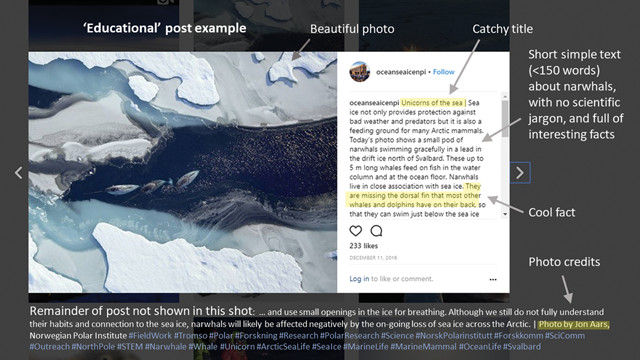
An example of an educational post from the @oceanseaicenpi Instagram account. Credit: Meyer et al., Oceanography, June 2018.
We at @oceanseaicenpi decided to classify our posts into seven categories — fieldwork, educational, project updates, historical, portraits of team members, publication highlights, and conference and meetings updates. Fieldwork posts talk about expeditions, instruments and field techniques; educational posts explain a scientific concept or introduce a topic such as ocean optics; project updates talk about ongoing projects and planned experiments; historical posts can be about famous scientists, historical expeditions or old maps, for example; team member portraits highlight individual scientists in our group; publication highlights present recently published papers by the team and collaborators; and finally, conference and meetings updates mention workshop attendance or advertise talks about to take place at a conference.
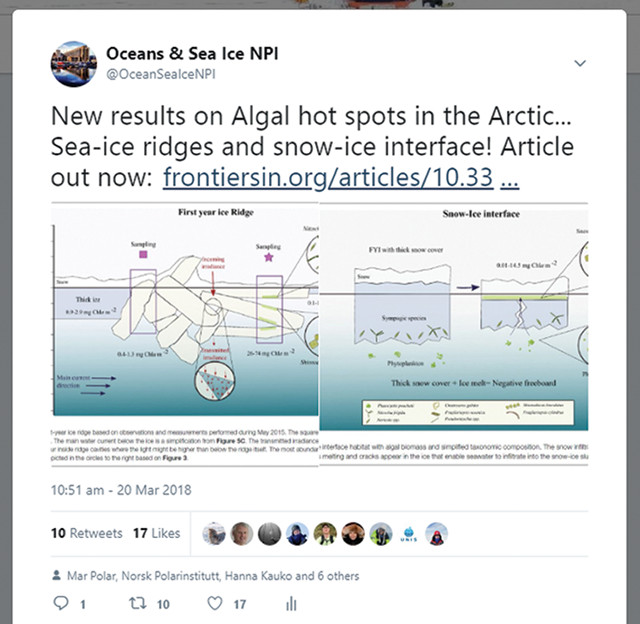
Example of a publication highlight post on the @oceanseaicenpi Twitter channel. Credit: Fernandez-Mendez et al., Frontiers in Marine Science, March 2018.
In terms of what we post to which platform, we have realized that certain types of posts are more popular than others and that followers on different social media channels have different preferences. We figured this out by keeping track of the number of likes and shares of each type of post. For our channels, fieldwork and educational posts are most popular on Instagram, publication highlights on Twitter, and team portraits on Facebook.
Finally, start posting! Each post should have one key message, ideally explained in less than 150 words and, vitally, accompanied by an engaging photograph or illustration. Be accurate and check your facts. And use tags and hashtags — like #SciComm or #polarfox, matching the theme of the post — to increase your reach.
Get to know your audience and post when your followers are most responsive. You can work this out using the built-in analytics for each platform, which provide basic statistics: information such as who and where your followers are, when they are online, how much they clicked or shared a post, and what their interests are. Analytics can also help you assess the impact of your social media outreach.
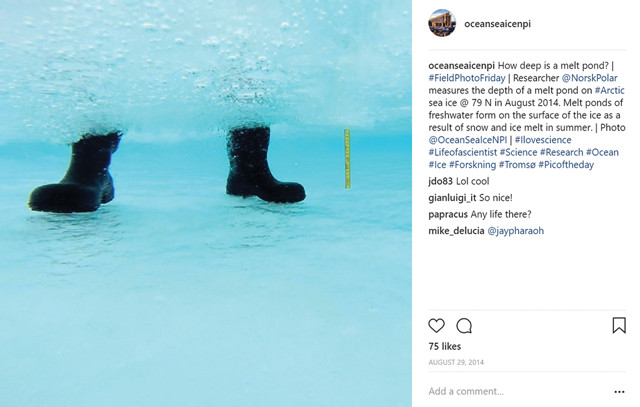
Example of an @oceanseaicenpi post on Instagram showing a researcher standing in a melt pond atop Arctic sea ice, which is about 1 meter thick. Credit: Alexey Pavlov (NPI).
More and more individual researchers are using social media platforms (especially Twitter) for professional networking and science communication. But the numbers of scientists and research groups on social media are still low.
Running social media channels can be time-consuming, especially if you’re doing it on your own, and it requires adept coordination if it’s a team effort. It might seem easier to work on overdue manuscripts than to invest time in new outreach tools. Nonetheless, scientists should be taking advantage of these tools to better communicate our science.
© 2008-2021. All rights reserved. Any copying, redistribution or retransmission of any of the contents of this service without the expressed written permission of the American Geosciences Institute is expressly prohibited. Click here for all copyright requests.